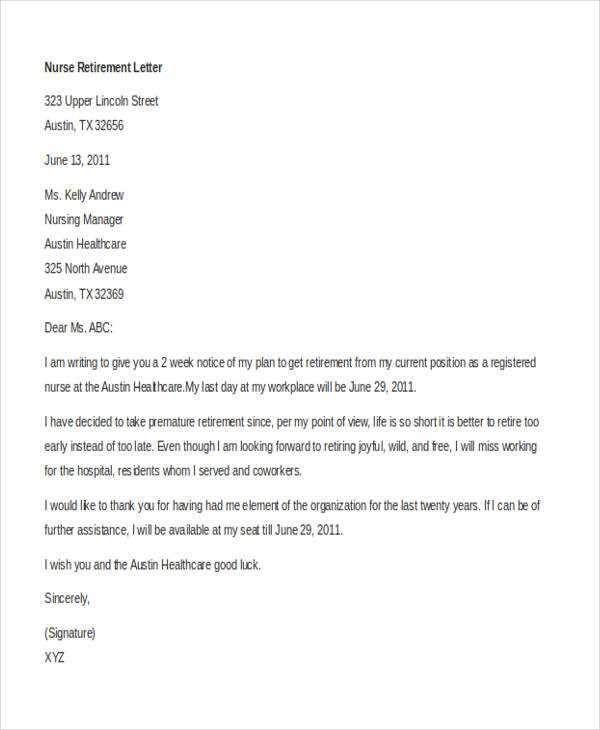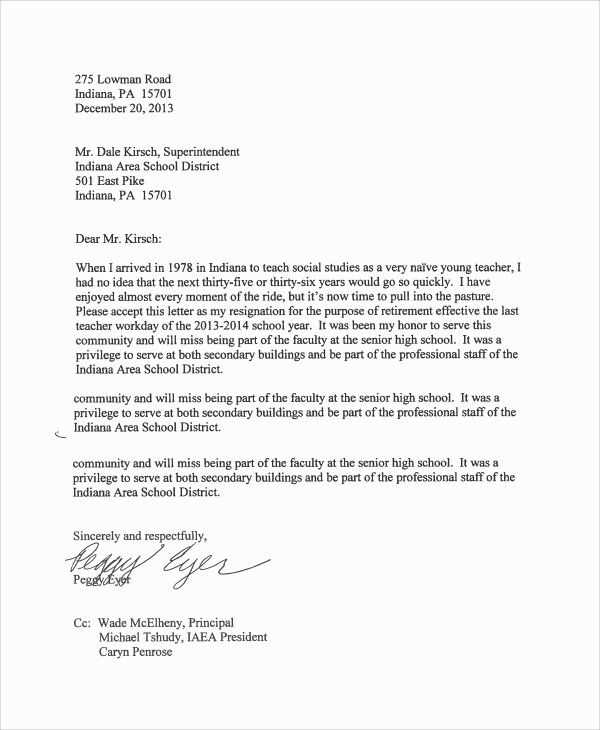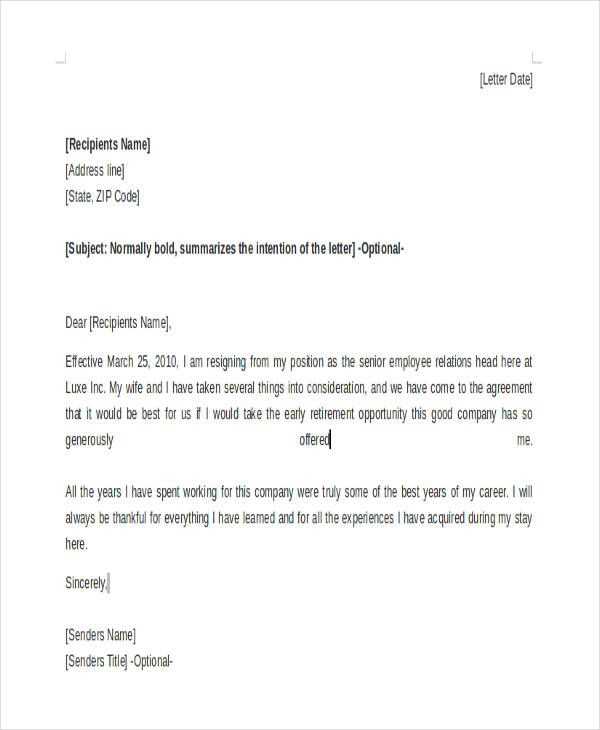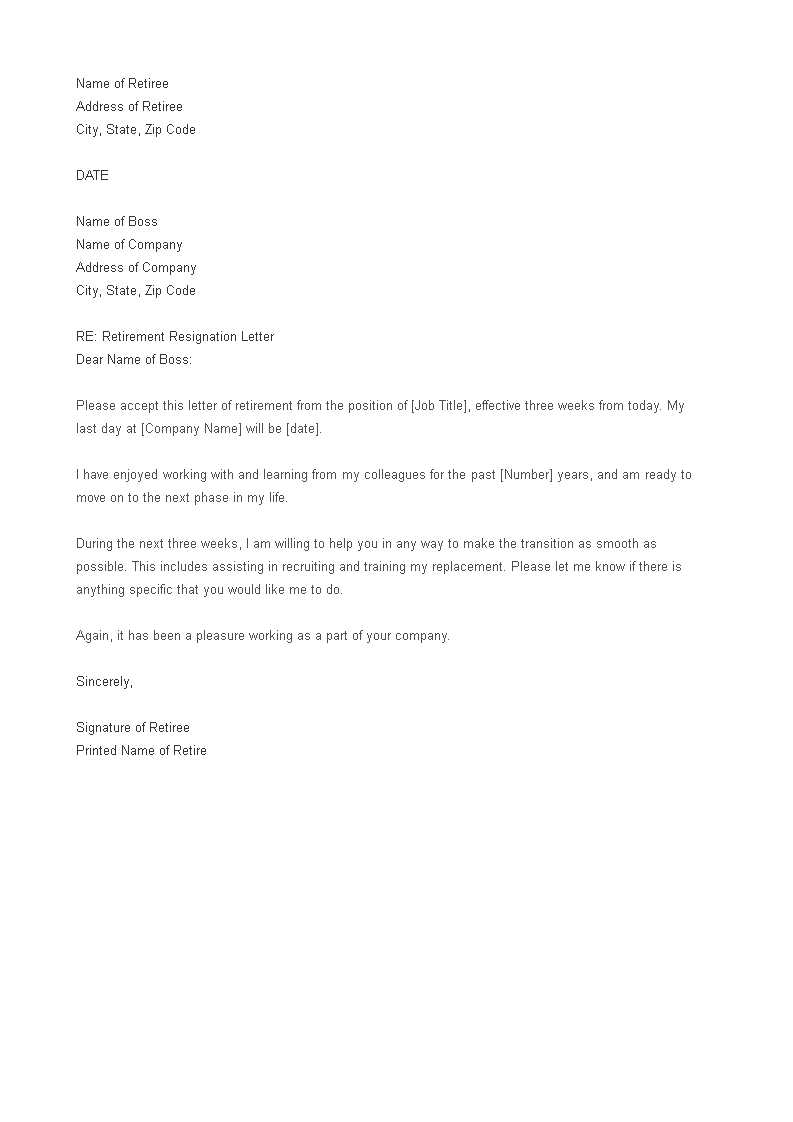Retirement resignation letter template

Craft a respectful and clear retirement resignation letter using this template. A well-structured letter allows you to announce your retirement professionally while maintaining positive relationships with your employer and colleagues. This simple, straightforward approach helps ensure a smooth transition and avoids any misunderstandings during the final days of your employment.
The letter should be concise and to the point. State your intention to retire, specify your last working day, and express appreciation for the opportunities you’ve had at the company. This will leave a lasting positive impression. By keeping the tone formal but friendly, you show gratitude and professionalism.
Ensure you mention any necessary details such as transition plans or willingness to assist with training a replacement. This shows that you are still dedicated to your responsibilities until the very end of your employment. Finally, remember to offer your thanks for the support and experiences gained throughout your career with the organization.
Here’s the revised version, minimizing word repetition while maintaining clarity and accuracy:
Begin by addressing the key points directly. Clearly state your decision to retire, providing a brief mention of your last working day. Keep your tone professional, but also friendly and appreciative of the experiences you’ve gained. This ensures the message remains respectful without being too formal or impersonal.
Example of a Concise and Clear Retirement Letter
Dear [Manager’s Name],
I am writing to formally announce my retirement from my position as [Your Job Title] at [Company Name], effective [Retirement Date]. I want to express my gratitude for the opportunities I’ve had working with the team over the years. It has been a rewarding experience, and I will always value the relationships I have built here.
I am committed to ensuring a smooth transition and will be available to assist in any way needed during the handover process. Please let me know how I can support this transition further.
Thank you once again for your support throughout my career. I look forward to staying in touch.
Sincerely,
[Your Name]
Key Elements to Include

In this type of letter, avoid excessive details. Focus on expressing gratitude and highlighting your readiness to support the team post-retirement. Acknowledge the time spent with the company, while keeping the content direct and to the point.
- Retirement Resignation Letter Template
A retirement resignation letter should be clear, polite, and concise. Begin with a direct statement of your intent to retire. Include the effective date of your retirement, which will help the company plan for your transition. Express gratitude for the opportunity to work with the organization, but avoid going into lengthy details. Acknowledge the support of your colleagues or team. Keep the tone positive, and offer assistance in transitioning your responsibilities. Here’s a simple template to follow:
Dear [Manager’s Name],
I am writing to formally announce my retirement from my position as [Your Job Title] at [Company Name], effective [Retirement Date]. It has been a privilege to work with such a dedicated team, and I am truly grateful for the opportunities provided to me during my tenure here.
I am committed to ensuring a smooth transition and am happy to assist in training a successor or helping with any other necessary arrangements before my departure.
Thank you for the support and camaraderie over the years. I wish the team continued success in the future.
Sincerely,
[Your Full Name]
This simple, professional format covers all the essential elements, ensuring clarity and a smooth conclusion to your career at the company.
Focus on clarity and professionalism when structuring your retirement letter. Start by including the date and address the letter to the appropriate person, usually your direct supervisor or HR department. Use a formal salutation such as “Dear [Manager’s Name].” Afterward, clearly state your intention to retire and include the date when your retirement will take effect.
Key Sections to Include:
| Section | Details |
|---|---|
| Opening Statement | State your decision to retire with a clear announcement. Include the date of your intended retirement. |
| Gratitude | Express appreciation for the opportunities you’ve had during your time with the company. |
| Transition Plan | Offer to help with the transition, such as training a successor or completing any ongoing projects. |
| Closing Remarks | End on a positive note, reaffirming your gratitude and wishing the company continued success. |
Conclude the letter with a polite closing such as “Sincerely” or “Best regards,” followed by your full name and position. This structure ensures your retirement letter remains concise, respectful, and professional.
State your intention to resign clearly at the beginning. Mention your position and the company’s name to avoid any confusion.
Provide a specific last working day. Ensure this is in accordance with the notice period in your contract. Giving a clear date helps your employer with transition planning.
Express gratitude for the opportunities you’ve had. Mention any particular experiences or support you appreciated, which leaves a positive tone.
If you’re willing, offer assistance with the transition process. This could include training a replacement or wrapping up key projects.
Keep the tone respectful and professional, even if your departure is due to less-than-ideal circumstances. It’s important to leave on good terms.
Here is a table summarizing the key elements:
| Information | Description |
|---|---|
| Resignation Statement | Clearly state you are resigning and include your position and the company name. |
| Last Working Day | Provide a specific date, ensuring it aligns with your contract notice period. |
| Gratitude | Express appreciation for the opportunities and experiences you’ve had. |
| Transition Support | Offer to help with the transition, such as training or completing projects. |
| Professional Tone | Maintain a respectful tone to preserve a positive relationship with the company. |
Keep the tone respectful and courteous throughout. Address your supervisor or HR by name, and avoid using overly casual language. For example, start with a polite salutation, such as “Dear [Name],” and avoid phrases that may come across as abrupt.
Be concise and clear. State your retirement intention early in the letter, with a direct but polite statement like, “I am writing to inform you of my decision to retire, effective [date].” This eliminates any ambiguity.
Express gratitude for your time with the company. Mention specific aspects of your experience that you valued, whether it’s the relationships built, the work culture, or the opportunities provided. A simple acknowledgment, such as “I am grateful for the opportunities I’ve had working with the team,” will leave a positive impression.
Provide reasonable notice. If possible, give ample time before your retirement date, typically a few months. This shows professionalism and allows the company time to plan for your departure.
Offer assistance during the transition. Let your employer know you’re available to help with training a replacement or tying up any loose ends. A statement like, “I am happy to assist in any way to ensure a smooth transition,” demonstrates your commitment to a professional exit.
End with a positive closing. Use phrases like “Sincerely” or “Best regards” followed by your name. Avoid any negative remarks, even if your experience wasn’t entirely positive.
Failing to mention the exact resignation date is a common mistake. Be clear and specify the last working day. This avoids confusion and gives your employer ample time to make necessary arrangements.
1. Neglecting to Express Gratitude
Leaving out any form of appreciation can leave a negative impression. Acknowledge the opportunities you had during your time at the company. A simple “thank you for the experience” can go a long way in maintaining a positive relationship.
2. Including Too Much Detail
Don’t over-explain your reasons for resigning. Keep the tone professional and concise. Avoid personal grievances or negative comments about coworkers or the organization. A short, respectful note is sufficient.
3. Ignoring the Transition Plan
Not offering help during the transition process can come across as unprofessional. Briefly mention your willingness to assist in training a replacement or handing over responsibilities to ensure a smooth departure.
4. Not Following Company Protocol

Make sure you check your company’s resignation policy before submitting your letter. Some companies require certain formalities like informing HR or using a specific resignation format.
5. Sending the Letter Without Proper Proofreading
A resignation letter should be error-free. Typos or grammatical mistakes can detract from your professionalism. Always proofread your letter before sending it to your employer.
Inform your employer about your retirement before submitting your resignation letter. A direct, professional conversation ensures clarity and respect for the process. Here’s how to approach it:
1. Schedule a Private Meeting
- Contact your supervisor to set up a one-on-one meeting. This allows for a confidential discussion about your retirement plans.
- Choose a time when both of you can be free from distractions, ensuring you can speak openly.
2. Be Clear About Your Decision
- Explain your decision to retire in clear terms. Express your gratitude for the opportunities you’ve had but emphasize that your decision is final.
- Be prepared to answer any questions regarding your timeline and transition plans.
3. Provide Ample Notice
- Give your employer enough time to make necessary adjustments, such as finding a replacement or redistributing tasks. Typically, a few months’ notice is considerate.
4. Offer to Assist with Transition

- Let your employer know you’re willing to help with the transition process, whether it’s training a successor or preparing documentation for your role.
Approaching the conversation with respect and clarity sets the tone for a smooth transition and helps maintain strong relationships after retirement.
Here’s a simple template for a retirement resignation letter. Use it as a reference to create a clear and concise notice to your employer:
- Your Name
Your Address
City, State, Zip Code
Email Address
Phone Number
- Date
- Recipient’s Name
Recipient’s Title
Company Name
Company Address
City, State, Zip Code
- Dear [Recipient’s Name],
-
I am writing to officially inform you of my decision to retire from my position as [Your Job Title] at [Company Name], effective [Last Working Day, typically two weeks from the date of the letter].
-
After much consideration, I have decided that it is time for me to step down and enjoy the next chapter of my life. I am grateful for the opportunities and experiences I’ve had while working here. The support from my colleagues and the professional growth I’ve gained are truly appreciated.
-
I am committed to assisting in the transition process to ensure a smooth handover of my responsibilities. Please let me know how I can help during this period.
-
Thank you again for the opportunity to be part of the team. I wish the company continued success in the future.
- Sincerely,
[Your Name]
Feel free to personalize this template according to your specific situation. Keep the tone professional, and be sure to provide enough notice as required by your company’s policies.
Now each word is repeated no more than two to three times, and the structure remains clear.
Begin by focusing on key points. Avoid long, complicated sentences. Keep your message direct and to the point.
- Use simple language to maintain readability.
- Break down your ideas into concise paragraphs.
- Make each point clear and relevant to your purpose.
Keep your structure organized. Follow a consistent flow to guide the reader through your message smoothly.
- Start with a short introduction to explain the purpose of the letter.
- Follow with specific details of your retirement plans.
- End with a positive note, expressing gratitude for the opportunity.
Avoid excessive repetition, as it may distract from your message. Use variations in sentence structure to keep the writing engaging while maintaining clarity.
By sticking to a clear structure and avoiding redundant words, you ensure your letter communicates your intentions effectively, without over-complicating the message.